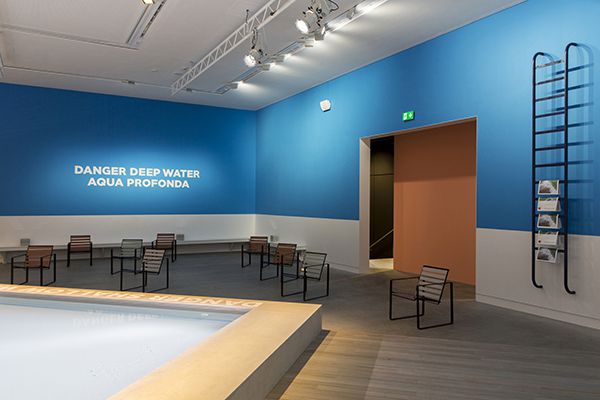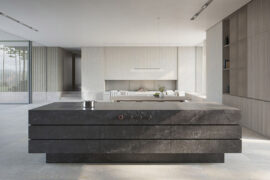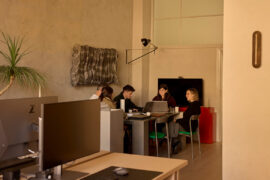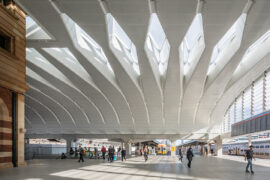The Pool is proving a hit at the 2016 Architecture Biennale as visitors lap up a deliberately different approach to architectural storytelling.

June 6th, 2016
Michelle Tabet couldn’t be happier to see little piles of belongings dotting the poolside timber bleachers at the Australian exhibition for Biennale Architettura 2016, which she created with fellow creative directors and officemates Isabelle Toland and Amelia Holliday of Aileen Sage Architects.
The exhibition, which opened just over a week ago, explores Australian culture through the cherished local institution of the public swimming pool. And while the water in the 60-metre-pool that dominates the space may only be 30 centimetres deep, visitors are clearly entering into the spirit of things, enticed by clever lighting, scent design evoking gum trees after rain, and stories of the pool from well-known Australians including Ian Thorpe and Paul Kelly, broadcast via poolside radios.
“It’s amazing because the exhibition opened and within a couple of hours people were just taking to the water and wading through it and sitting on the bleachers and leaving their stuff in little piles – like you do at the pool, you know?” Tabet says. “My shoes, my bag, kind of covering it up so that nobody will steal it but I don’t expect anyone to steal it? That’s what started happening, people colonising the space in exactly the way we intended it. People keep telling us that this is going to be really popular in the summer months.”
Tabet is delighted that design team’s determination to “break away from that purely architectural show” is paying off. Even non-English speakers have been mesmerised by the aural storytelling at the heart of the exhibition, which has also been captured in a commemorative book and a podcast series by Radio National. “It puts all these different people in conversation,” Tabet says.
Fittingly for an exhibition designed to engage non-architects in a conversation about public space, the designers were inspired by stories and images crowd-sourced from pool lovers from Fitzroy in inner Melbourne to the Kimberley and Far North Queensland. “The massive insight from the crowd sources that was really, really helpful was that the way to talk about the pool wasn’t listing pools or dissecting the way they were built or their siting or any of that kind of architectural stuff,” Tabet says. “It was really much more about the stories people were offering up. This is where I’m terrified of jumping off the diving board, or this is where I used to go with my grandpa, or this is where my kids are learning to swim. There were all these personal stories and we realised that the crowd-sourcing had become a platform for us to curate those stories and we needed to respect the story format. We couldn’t analyse or present the information in a different way because that’s the most natural way that the pool wants to be talked about.”
Australian Institute of Architects
architecture.com.au
INDESIGN is on instagram
Follow @indesignlive
A searchable and comprehensive guide for specifying leading products and their suppliers
Keep up to date with the latest and greatest from our industry BFF's!

For those who appreciate form as much as function, Gaggenau’s latest induction innovation delivers sculpted precision and effortless flexibility, disappearing seamlessly into the surface when not in use.

Welcomed to the Australian design scene in 2024, Kokuyo is set to redefine collaboration, bringing its unique blend of colour and function to individuals and corporations, designed to be used Any Way!

London-based design duo Raw Edges have joined forces with Established & Sons and Tongue & Groove to introduce Wall to Wall – a hand-stained, “living collection” that transforms parquet flooring into a canvas of colour, pattern, and possibility.

For Aidan Mawhinney, the secret ingredient to Living Edge’s success “comes down to people, product and place.” As the brand celebrates a significant 25-year milestone, it’s that commitment to authentic, sustainable design – and the people behind it all – that continues to anchor its legacy.

Dr Michael Mossman and Jack Gillmer-Lilley, two of the Creative Directors for the 2025 Australia Pavilion, join us for an in-person podcast to discuss their project, HOME, and Indigenising the built environment.

To be housed in the 1460 armoury building Sale d’Armi in Arsenale, Venice, this year’s Singapore Pavilion responds to the 18th International Architecture Exhibition’s theme — The Laboratory of The Future — but taking the form of a giant evolving machine that seeks to understand our true desires for how we live in the city.

Tristan Wong (SJB) and Jefa Greenaway (Greenaway Architects and Academic) have been announced as creative directors for the 2020 Venice Biennale, alongside a team of collaborators.

The theme for this year’s Biennale, ‘Reporting From the Front’, set by Creative Director Alejandro Aravena, sought projects that tackled issues like segregation, inequalities, peripheries, natural and social disasters, housing shortages, migration, informality and communities. Hahna Busch reports from the front.
The internet never sleeps! Here's the stuff you might have missed

Founded by Ana Ćalić McLean and Josh McLean, In Addition is a design studio creating thoughtful, client-focused architecture and interiors.

The Australian Institute of Architects has unveiled 43 projects representing the pinnacle of contemporary design, with winners addressing housing, climate and affordability crises through innovative solutions.